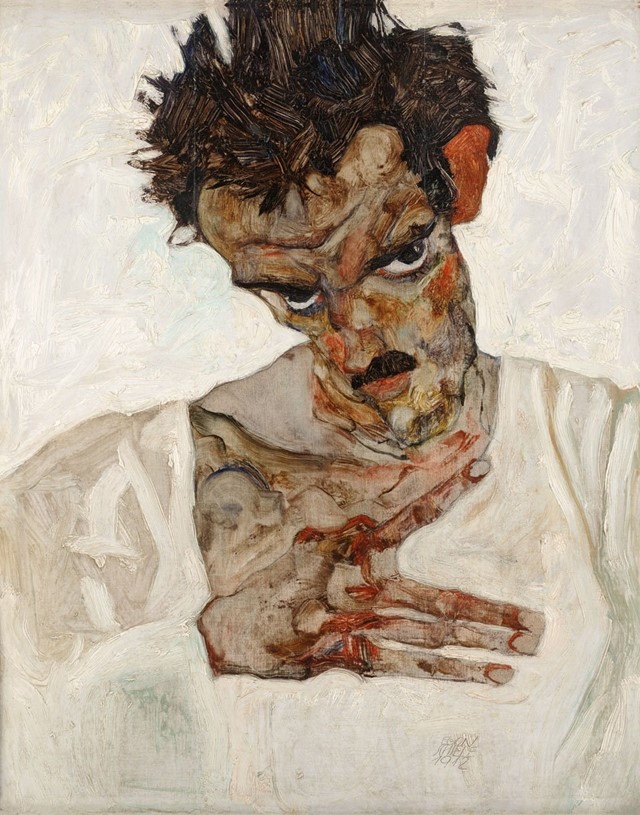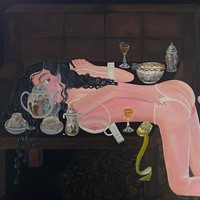As more men face allegations of shitty behaviour, we ask two writers to discuss what to do with their work
Another day, another headline about an artist/filmmaker/actor/YouTuber’s dodgy behaviour. The latest to come under fire are artist Chuck Close and photographer Thomas Roma, whose installations – about a dozen works each – at Washington DC’s National Gallery of Art have been put on hold indefinitely after sexual allegations were made against them. In record time, institutions have already begun to cull their works. It seems the art world can no longer avoid the question, how do we punish them for their crimes without erasing art history?
Men behaving badly is nothing new. We’ve known about the fuckery of Egon Schiele and Pablo Picasso, amongst others, for years. It’s not hidden – it’s all printed in our history books. However, more recently, hoards of women and queer people have come forward with horrific stories of sexual assault and abuse at the hands of men who are still alive. Do we condemn the dead as we would the living? If the artist contributed majorly to art history, are they exempt? If Kevin Spacey can be fired from House of Cards does that mean we can remove predatory artists from our gallery walls? A simple yes or no answer without nuance or context is absolutely not possible. And most often, saying yes will cross over into no territory, and vice-versa, as we found when we asked two writers, Chris Hayes and Elise Bell, to argue each side.
FOR THE REMOVAL OF ARTWORKS
“Museums and galleries across the world are slowly facing up to the fact that they have large amounts of money and intellectual effort invested in the work of abusive men. For example, a lot of people have staked whole careers on Picasso, who once said, ‘for me, there are only two kinds of women, goddesses and doormats’. So when the National Gallery of Art announced that they were cancelling solo exhibitions from both painter Chuck Close and photographer Thomas Roma due to accusations of sexual misconduct, this was big news. Should everyone else face up to the dark secrets of their collections?
I studied painting, have exhibited paintings and think Chuck Close is fantastic. Really, you can’t talk about Photorealism without mentioning him and that’s an essential part of painting’s relationship with photography. Big stuff. Yet so far, four women have claimed that Close invited them to his studio, asked them to model nude for him and then used very explicit language – in one encounter saying, ‘your pussy looks delicious’ – making them feel uncomfortable, manipulated, and exploited; it’s time to listen. Do we need another Chuck Close exhibition? This is essentially the issue House of Cards faced. What did they do? Ditch the problem guy, and promote the woman. I want curators to learn from House of Cards, and make the next season of art more diverse, more radical and most of all, safe. Another exhibition from Chuck Close or whoever doesn’t achieve that.
“Is it censorship? Is it an attack on the freedom of art and artists? No, it is about time” – Chris Hayes
The question about judging the art or the artist is an ancient one. Shouldn’t we simply judge the work itself? That’s why we’re here, right? – who actually cares about the personal life of some guy who liked to paint so much that he eventually became weirdly, fantastically good at it?! But that’s the problem. These things aren’t separate issues. Our understanding of art is shaped by the very culture that kept it as the plaything for rich, straight, white men. Another exhibition from someone with sexual misconduct allegations against them isn’t what we need from art now. Is it censorship? Is it an attack on the freedom of art and artists? No, it is about time.
But there is good news. Recently, due to sexual misconduct claims a German museum has suspended a major retrospective for Bruce Weber and the Tate has suspended a relationship with a prominent dealer. London’s art institutions have very recently hosted a number of major exhibitions that are building on the great work of activism to turn the needle in the art world. A major retrospective for Rachel Whiteread at Tate Britain was long overdue, as was the retrospective for Jean-Michel Basquiat at the Barbican (both should have happened about 10 years ago). And Tate Modern held two monumental exhibitions about often overlooked histories, in Queer British Art and Soul of a Nation. So should institutions continue cancelling exhibitions from problematic artists? Absolutely, if we don’t want art to remain stale, pale and male.”
– Chris Hayes is an artist and writer (Time Out, Circa Art Magazine) from Ireland. Follow him here
AGAINST THE REMOVAL OF ARTWORKS
“Art history is problematic. It’s easy to despair at the white walls of institutes like the Tate or National Gallery, often decked by artists whose biographies read like a who’s who of misogyny and dangerously predatory (often) male ‘geniuses’. Yet outside of debates like Rhodes Must Fall, where the physical monument leads to the celebration of terrible people, artists have the benefit of being somehow separate from the work they produce. When we are admiring a Picasso, it’s the physical work on canvas that we appreciate. Read any biography and you’d know the man himself is a monster.
It’s this dissonance that often makes the appreciation or the understanding of art so difficult. Can you love an artist’s work if behind the canvas is a life marked by acts of sexual assault, rape or appropriation? These are questions we have to ask ourselves, especially in light of upcoming exhibitions such as Schiele at the RA and Tate Liverpool or Picasso at Tate Britain. They’re important and difficult questions – best observed in the recent Balthus controversy – but ultimately the answer to any of them does not lie in the removal of artworks. You can’t and shouldn’t erase art history but we can certainly stop history from repeating itself.
As society shapes itself around the consequences of the #MeToo movement, there is an opportunity for large-scale institutions to use their collections as a way to revisit important critical discussions within the discipline. Conversations need to happen.
“When we are admiring a Picasso, it’s the physical work on canvas that we appreciate. Read any biography and you’d know the man himself is a monster” – Elise Bell
This methodological curatorial approach, whilst not entirely new, remains controversial. In 2015, The Rijksmuseum took the decision to rename culturally insensitive painting titles. In practice, this resulted in the renaming of Simon Maris’ “Young Negro-Girl” to “Young Girl Holding a Fan” as well as numerous others. Alongside this, information attesting to the compromising former names and further history of colonial Dutch practices were included. The unnecessary furore had the works been removed entirely, which would have played into the hands of conservative commentators, instead became a point for education and self-interrogation.
In stark contrast, The Art Institute Chicago recently came under deserved criticism for blatantly ignoring Gauguin’s inherent controversies in an exhibition dedicated to his life and work. Gauguin’s voyeuristic gaze on Tahitian culture; his overt sexualisation of young women of colour, and then his marriage to a child bride are not facts to be swept under the dark carpet that is art history. It was a missed opportunity and one which reminds us of the regressive politics and conscious ignorance of major institutions.
In the case of men like Chuck Close, the difference is he is a living artist. A living breathing artist with numerous accounts of sexual assault and battery to his name. If anything is to be learned from the past, it is that there are enough tyrannical and abusive men in the history of art to negate the need for institutions to give living men the same platform. Plus his work isn't even that good anyway.”
– Elise Bell is a writer and the founder of @tabloidarthistory. Follow her here




